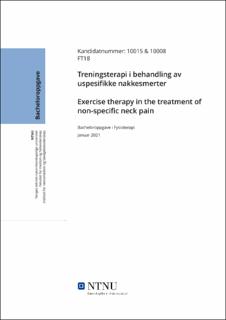| dc.contributor.advisor | Hals, Odd Magne | |
| dc.contributor.author | Råum, Erlend Dragland | |
| dc.contributor.author | Tvedt, Fredrik | |
| dc.date.accessioned | 2021-09-25T16:27:39Z | |
| dc.date.available | 2021-09-25T16:27:39Z | |
| dc.date.issued | 2021 | |
| dc.identifier | no.ntnu:inspera:67905760:68151600 | |
| dc.identifier.uri | https://hdl.handle.net/11250/2783115 | |
| dc.description.abstract | Tittel: Treningsterapi ved uspesifikke nakkesmerter
Problemstilling: Hva har vist den største reduksjonen i smerteintensitet hos voksne mennesker med uspesifikke nakkesmerter; dynamiske styrkeøvelser for nakke- og skulder, eller aerobe treningsformer som tar i bruk store muskelgrupper i hele kroppen?
Hensikt: Sammenligne studier som enten har sett på dynamisk styrketrening (DS) eller aerobe treningsformer (AT) som treningsintervensjon hos mennesker med uspesifikke nakkesmerter, og drøfte betydningen av disse funnene med den hensikt å avdekke hvorvidt én av treningsintervensjonene viser større smertereduserende effekt enn den andre.
Metode: Litteraturstudie, utført i databasene «PubMed» og «PEDro» i uke 46, 2020.
Resultat: Totalt ble seks studier med til sammen 479 subjekter inkludert i denne litteraturstudien. Alle studiene hadde benyttet randomisert kontrollert studie som studiedesign. Blant de seks inkluderte studiene var det fem DS-grupper og fire AT-grupper. DS-gruppene hadde en gjennomsnittlig reduksjon på 2,51 på numerisk smerteskala (NRS) etter intervensjonsperioden. AT-gruppene hadde en gjennomsnittlig reduksjon på 2,54 på NRS etter intervensjonsperioden.
Konklusjon: Basert på studiene inkludert i denne litteraturstudien er det ikke tilstrekkelig evidens for å hevde at én av treningsintervensjonene (AT eller DS) fører til en større reduksjon i smerteintensitet hos voksne mennesker med uspesifikke nakkesmerter enn den andre. Videre forskning som sammenligner AT direkte med DS anbefales for å belyse dette temaet ytterligere. | |
| dc.description.abstract | Title: Exercise therapy in treatment of non-specific neck pain
Research question: Which of these two exercise modalities have displayed the greatest reduction in pain intensity for adults suffering from non-specific neck pain; dynamic strengthening exercises for the neck and shoulder muscles, or aerobic exercises which utilizes large muscle groups in the whole body?
Aim: To compare studies which have investigated the use of either dynamical strengthening exercises or aerobic exercises in the treatment non-specific neck pain, and to discuss the results of these studies to investigate the possibility that one of these training modalities have a better effect than the other when it comes to pain reduction.
Method: Review. Online searches conducted in the databases “PubMed” and “PEDro” in week 46, 2020.
Results: Six studies with a total of 479 subjects were included in this review. All the studies included had the used randomized control trial as their study design. Among the six studies included, there were a total of five groups conducting dynamical strengthening exercises, and four groups doing aerobic exercises. The dynamical strengthening groups showed an average reduction of 2,51 on The Numerical Rating Scale (NRS) after the treatment period, while the groups performing aerobic exercises showed an average reduction of 2,54.
Conclusion: Based on the studies included in this review, there is not enough evidence to claim that one of these training modalities (dynamical strengthening exercises and aerobic training exercises) are more superior than the other when it comes to reducing paint intensity in adults with non-specific neck pain. Further research that compares dynamical strengthening exercises with aerobic exercises directly is needed to illuminate this topic to a greater extent. | |
| dc.language | nob | |
| dc.publisher | NTNU | |
| dc.title | Treningsterapi ved uspesifikke nakkesmerter | |
| dc.type | Bachelor thesis | |
